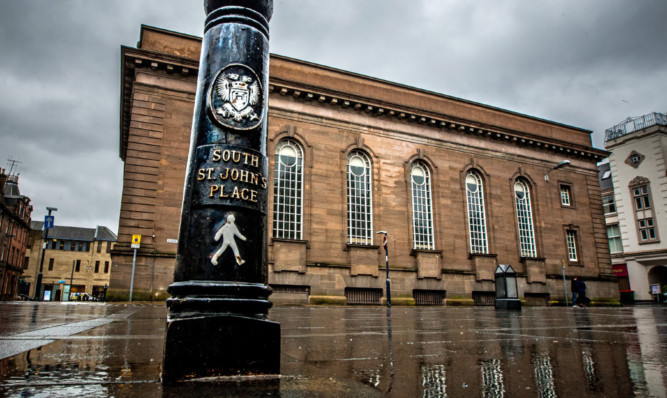An eminent author has concluded that the design of Perth City Hall hides secret links to the mysterious world of Freemasonry.
Richard A. Batchelor found startling evidence that the proportions of the Edwardian hall mirror almost exactly the dimensions of Solomon’s Temple a central symbol of Freemasonry.
Co-editor of a book about megalithic mathematics which describes how the ancients were aware of and used certain geometric values, yardsticks and proportions in buildings, Mr Batchelor wondered if there was some special geometry embedded within the city hall while looking at the civic structure.
“As a regular visitor to Perth I have been intrigued by this building which I feel dominates its environment and overshadows the medieval church next door,” said Mr Batchelor, 67, who lives near Cupar.
“The overall shape reminded me of Solomon’s Temple, built c. 960 BCE as a sacred shrine, and destroyed c. 420 BCE. I found plans for both Solomon’s Temple and Perth City Hall and proceeded to take some measurements.
“Given the different scales of the plans, I used ratios of measurements in order to compare like with like. “
This revealed that the proportions for length/width, small hall/large hall and the outer walkway correspond and are almost exactly the same.
“This suggests to me that the architect had knowledge of what has been termed sacred geometry, a knowledge which is embedded in Freemasonry,” said Mr Batchelor. “Also, Solomon’s Temple is a central symbol of Freemasonry. This implies that the architect was probably a Freemason so I delved a bit deeper.
“The architects for Perth City Hall were H. E. Clifford and Thomas Lunan of Glasgow.
“In particular, it is recorded that Clifford was engaged in at least three projects which involved masonic symbols 646 Argyle Street, Glasgow, panel with Masonic insignia, five busts and a deer’s head, 1869; 70 Glencairn Drive, Pollokshields, Glasgow, Masonic symbols and a pair of lions, 1888-1890; 98 West Regent Street, Glasgow, statues of St John the Baptist and St John the Evangelist on former Masonic halls, 1896. Freemasons traditionally celebrate the feasts of both St Johns.
“I conclude Perth City Hall was designed by an architect who was a member of the Freemasons and who used the geometries of Solomon’s Temple.”
An honorary research fellow in the department of earth and environmental sciences at St Andrews University, Mr Batchelor stressed that his interest in city hall was purely personal and didn’t wish to speculate on any wider hidden meaning the design may have.Fascinated by the societyThe world of Freemasons has long been shrouded in mystery but in the modern era it has become more open.
In recent times charitable work has been highlighted to counteract claims of undue influence wielded bymembers on other members.
The Grand Lodge of Scotland says there is nothing hidden in the world of Freemasonry and it is an opportunity for like-minded men to meet together.
“Freemasonry is a society of men concerned with moral and spiritual values. The essential qualification for admission and membership is a belief in a Supreme Being.
“Membership is open to men of any race or religion who can fulfil this essential qualification and who are of good repute.”
Famous Freemasons include Peter Sellers, the Duke of Wellington,Robert Burns, King George VI and Harry Houdini.
Nevertheless the enduring public fascination with Freemasons remains and was the subject of a book bybest-selling Da Vinci Code author Dan Brown.
The Lost Symbol follows Robert Langdon, an expert in symbols, trying to crack a series of cryptic clues related to Masonic secrets hidden in some of Washington’s most famous buildings.
